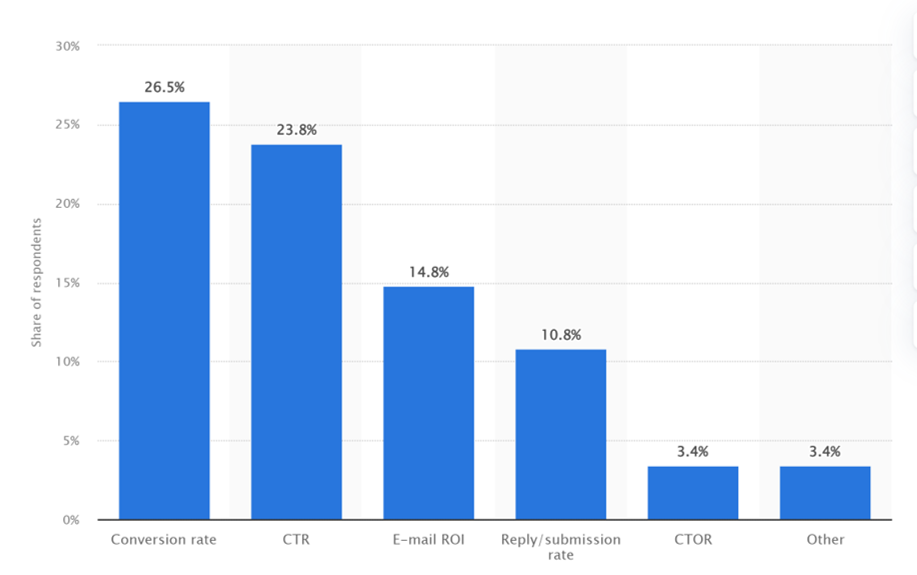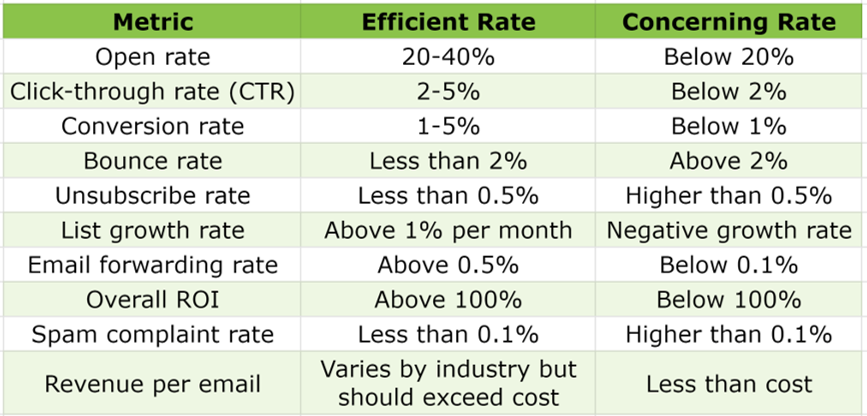- Home
- Statistics and Analytics
- Email Marketing Analytics: 10 ...

Email marketing is still one of the most effective strategies for businesses aiming to nurture leads, enhance customer engagement, and drive conversions. But to build an email marketing campaign that works you will need robust email marketing analytics.
When you understand and leverage key email marketing metrics, you are not just measuring success. You are getting valuable data that will help you optimize every aspect of your email communications.
In a survey conducted among marketers from nine countries, the conversion rate—defined as the percentage of viewers who converted out of the total number of viewers—was the top metric for assessing the success of email marketing campaigns, aside from the open rate, with 26.5 percent of professionals favoring it. The click-through rate (CTR)—the proportion of clicks an ad receives relative to its total displays—was the second most preferred metric, chosen by nearly 24 percent of marketers.

The table below highlights key email marketing metrics, their efficient and concerning rates; each metric will be discussed in detail in the subsequent sections of this article.

Why You Should Measure Email Metrics
Email marketing can be direct, personal, and effective. But in order for it to work, you will need to know just how well your email campaigns are doing. Without accurate evaluation of their performance, you will have no idea if your messages are hitting or missing the mark.
1. Enhancing engagement
Email marketing metrics are here to give you a clear understanding of how your subscribers are interacting with your emails. You get to look into open rates, click-through rates, and engagement over time. Together, these metrics are a good way to determine what your audience is interested in.
2. Optimizing campaign performance
When you keep an eye on different metrics, you get to clearly see which elements of your email campaign are doing well and what needs improvement.
For example, a low open rate might suggest that you need to take another look at your subject lines. A low click-through rate, on the other hand, could indicate that the content of your email or its CTA are not effective.
3. Improving deliverability
Your emails must get to their intended destination. For this to happen, you will need to look into metrics such as bounce rates and spam complaint rates.
High bounce rates can damage your sender reputation. As a result, more of your emails will be blocked or filtered into spam folders
Similarly, high spam complaint rates can affect your ability to reach your audience. This is why it is absolutely essential that you keep these metrics in check.
4. Driving conversions
Ultimately, the goal of most email marketing campaigns is to drive conversions. This could be making a purchase, signing up for a webinar, or downloading a whitepaper.
Conversion rate is a direct measure of how well your email campaigns are achieving this goal.
When you know which emails convert, you can “borrow” successful elements for future campaigns and increase ROI.
5. Quantifying ROI
Email marketing metrics are the base for calculating your ROI.
When you track metrics (like conversion rates and revenue) for every email, you will have a very clear picture of how your marketing efforts correlate with business outcomes. This information will help you see if the resources you’ve spent on email marketing can be justified. It will also give you the data you need to budget your future campaigns.
6. Adapting to audience needs
The way your readers behave will change and their preferences will evolve. What was working for your subscribers yesterday may not be working today.
When you take the time to regularly measure and analyze key metrics, you will find it much easier to stay in tune with what your audience needs.
10 Email Marketing Metrics You Must Know
1. Open rate
- What it measures: The open rate shows a percentage of people who open your emails. It’s the first indication of how your emails are doing and if your subject lines are working.
- How to calculate:
- Efficient range: A good open rate will vary by industry. Overall, an open rate of 20-40% is considered good.
- Concerning range: An open rate below 20% may indicate that your subject lines are not engaging or that your emails are not reaching the right audience.
Never ignore the three key things you can to to boost your open rates:
- Optimize your subject lines
- Segment your email list
- And perfect your timing
Get the detailed guide on improving the open rate from this article: Average Email Open Rate: Benchmarks Across Industries
2. Click-through rate (CTR)
- What it measures: The CTR measures the percentage of subscribers who went on to click one or note links in your email. This metric will tell you if your email content and calls to action are effective.
- How to calculate:
- Efficient range: A CTR between 2-5% is generally considered good. But keep in mind that these can vary a lot by industry and depend on the nature of your campaign.
- Concerning range: A CTR below 2% probably sign and that your email content or CTA are not relaxing enough for your audience.
How to increase the email click-through rate:
- Personalize your content
- Use compelling calls to action
- Limit the number of links
3. Conversion rate
- What it measures: The conversion rate shows the percentage of email recipients who clicked on a link within your email and then went on to complete action — for example, they purchased something on your website. This metric is a direct indication of whether your email marketing efforts are meeting specific goals.
- How to calculate:
- Efficient range: A good conversion rate is typically around 1-5%. Naturally, higher rates are always better. But what you can achieve depends on the industry you are working in and how complex or an action your readers should take for the conversion to count.
- Concerning range: A conversion rate below 1% may indicate that your emails are not effectively driving recipients to take action, which could be due to various factors like poor targeting or unclear calls to action.
4. Bounce rate
- What it measures: The bounce rate measures the percentage of your total emails sent that could not be delivered to the recipient’s inbox. It helps identify the quality of your email list and the effectiveness of your email delivery practices.
- How to calculate:
- Efficient range: A bounce rate of less than 2% is generally considered good. This indicates a healthy email list with valid addresses.
- Concerning range: A bounce rate above 2% suggests that there may be issues with your email list, such as outdated or incorrect email addresses. High bounce rates can also affect your sender reputation.
3 main tips how to reduce your email campaign bounce rate:
- Clean your email list
- Check your sender reputation
- Avoid spam filters
5. Unsubscribe rate
- What it measures: This metric shows the percentage of recipients who choose to opt out of your email list after receiving an email. A high unsubscribe rate can be a red flag, indicating content that may not be relevant or engaging to your audience.
- How to calculate:
- Efficient range: Less than 0.5% is generally considered acceptable. A low rate suggests that your content is well-received by your audience.
- Concerning range: An unsubscribe rate higher than 0.5% might suggest that you need to reevaluate your content strategy or segmentation practices to better align with your audience’s interests.
6. List growth rate
- What it measures: This metric tracks the net growth of your email list over time. It takes into account new subscriptions, unsubscribes, and email bounces.
- How to calculate:
- Efficient range: A positive growth rate is desirable, with anything above 1% per month considered healthy, indicating active list growth.
- Concerning range: A negative growth rate indicates your list is shrinking. This often signals issues with engagement, content relevance, or acquisition strategies.
7. Email forwarding rate / Share rate
- What it measures: This metric assesses the percentage of recipients who found your email content engaging or valuable enough to forward it to others or share it using a “share this email” button.
- How to calculate:
- Efficient range: While any level of sharing is positive, a rate above 0.5% is particularly good, indicating high engagement and content value.
- Concerning range: A rate below 0.1% suggests that your content may not be compelling or useful enough to encourage sharing.
8. Overall ROI (Return on investment)
- What it measures: ROI quantifies the profitability of your email marketing campaigns by comparing the revenue generated against the costs.
- How to calculate:
- Efficient range: An ROI above 100% indicates that your email marketing efforts are generating more revenue than they cost to execute.
- Concerning range: An ROI below 100% means your campaigns are costing more than they’re bringing in, signaling a need for strategic adjustment.
9. Spam complaint rate
- What it measures: This metric shows the percentage of recipients who marked your email as spam. It’s a critical indicator of how your emails are perceived in terms of relevance and value.
- How to calculate:
- Efficient range: A spam complaint rate of less than 0.1% is typically considered acceptable.
- Concerning range: A rate higher than 0.1% is troubling and may affect your sender reputation. This could translate into problems with deliverability. This indicates a need to review your content strategy, list hygiene practices, and subscriber engagement.
10. Revenue per email
- What it measures: Revenue per email quantifies the financial return from each email sent. This metric is crucial for evaluating the direct economic effectiveness of your email marketing campaigns, helping to understand how well email efforts are translating into tangible business value.
- How to calculate:
- Efficient range: It varies significantly by industry and the average transaction size. However, any value that exceeds the cost of creating and sending those emails can be considered positive. For high-value products or services, even a smaller number of conversions can result in a good revenue per email.
- Concerning range: If the revenue generated is less than the cost of sending these emails, it’s a clear indicator that your email marketing strategy needs adjustment.
To Sum Up
Successful email marketing is all about understanding and applying key metrics. This is the one proven way to improve your strategy and get better results. The metrics we’ve gone over in this article will provide you with key data points. You can then use this data to make adjustments to fine-tune your campaigns for better engagement. Keeping it simple, understanding the KPIs above is essential for every marketer.



